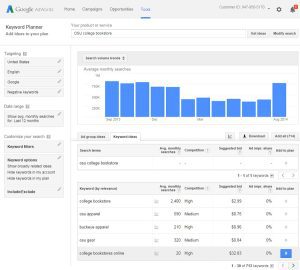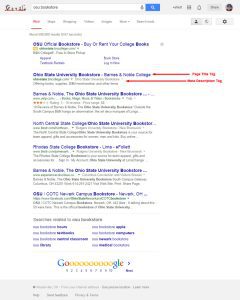How to Use Keywords
How to use keywords for better SEO
This set-by-step guide will help you better understand how keywords work and how to use them to give your website more visibility through organic search engine optimization.
The Basics
- Keywords are phrases made of multiple words. They don’t have to be single words, but can be.
- Each page of your site should be optimized for one specific keyword.
- Don’t optimize different pages for the same keyword, then you’re effectively competing with yourself for traffic.
- Capitalization doesn’t matter but word variations do (ie. plural vs. singlar).
 Step 1: Research your Keyword
Step 1: Research your Keyword
- Go to https://adwords.google.com/ko/KeywordPlanner
- Sign in to your Adwords account or create a new account if you don’t already have one.
- You don’t need to create an ad campaign or setup billing to use the Keyword Planner Tool.
- Click on Search for new keyword and ad group ideas.
- Enter a phrase in the top box that you think would be a good keyword, for example ‘college bookstore’.
- Click on ‘Get Ideas’
- Click the ‘Keyword ideas’ tab to open it up.
- This will give you an overview of how many people are searching for a keyword and what the competition is like. These numbers are very general and don’t represent exact totals.
- Competition is based on the number of other websites targeting that keyword. Keywords with High competition will be more difficult to use.
- Try to identify a keyword that has low competition and high Avg. monthly searches.
- Sometimes more specific terms will give better results than general ones.
- For example: OSU college bookstore vs. college bookstore
- Test variations of words and try to match exactly what people are typing into their search box.
- For example:
- college bookstore = 2,400 avg. monthly searches
- college bookstores = 320 avg. monthly searches
- For example:
- Once you’ve tried a few variations select a keyword to focus on. For this example we’ll focus on ‘OSU bookstore’.
 Step 2: Add the Keyword to your Page
Step 2: Add the Keyword to your Page
Search engines will crawl your page for keywords and match those to what people are searching for. You’ll want to add your keyword to the following areas of your page. Some locations are more important than others, generally text higher on the page has a higher ranking.
- Title Tag: This is the most important place for your keyword. Most search engines place a higher value on the title tag than body text or other areas.
- The title tag will be found at the top of your code and will look like this:
- <title>OSU Bookstore</title>
- Most CMS software like WordPress or Joomla will have a way to edit title tags without modifying any code.
- In the browser the title tag will be displayed in the top tab to identify a page.
- Title tags are also the first line shown on a search engine’s result page.
- Your title tag should be less than 70 characters.
- The title tag doesn’t have to use only your keyword. If you have space add meaningful text to the end of your title tag.
- Example: OSU Bookstore | The Ohio State University
- The title tag will be found at the top of your code and will look like this:
- Meta Description Tag: This is the description that appears in the list of search results.
- The description tag will be found at the top of your code and will look like this:
- <meta name=”description” content=”OSU Bookstore sells new and used books for students of the Ohio State University.” />
- Most CMS software like WordPress or Joomla will have a way to edit description tags without modifying any code.
- The description should be written for people, it should not be a list of keywords. Use proper punctuation and spelling.
- Try to work in your exact keyword towards the beginning of your description.
- The description should be limited to 156 characters.
- The description tag will be found at the top of your code and will look like this:
- Page URL: The URL is the address people type to reach your page.
- The beginning of the URL will always be your site name, but you can change the ending to match your keyword. The URL might look like this:
- https://triad-inc.com/blog/osu-bookstore.html
- Use a – character in place of spaces.
- Traditionally the URL was built as a path to a file on the server, to break it down:
- https://triad-inc.com = is the name of the hosting server
- /blog/ = is a folder on that server
- osu-bookstore.html = is a file in that folder
- Many newer sites don’t follow this structure and the URL will reference items in a database or follow another structure.
- Most CMS software like WordPress or Joomla will have a way to edit the URL without modifying any code.
- The beginning of the URL will always be your site name, but you can change the ending to match your keyword. The URL might look like this:
- Page Content: The actual text on the page.
- Make sure to include the keyword in the body copy of your page.
- Try to match the exact keyword without variations. You may need to reword some text to get this to work properly.
- Example: The OSU Bookstore has been serving students, faculty and staff for over 3 decades …
- Try to list the keyword 2-3 times throughout the page.
- Image alt Tags: Text descriptions for the images on a page.
- If your article has any images you can use the keyword in the alt tag. The code would look like this:
- <img alt=”OSU Bookstore” src=”https://triad-inc.com/wp-content/uploads/2014/08/search-map-small.png” >
- Most CMS software will have a way to edit the alt tags without editing any code.
- If your article has any images you can use the keyword in the alt tag. The code would look like this:
- Image Title Tag: A description tag used for each image.
- Images also have a title tag which can be used to for keywords. The code would look like this:
- <img alt=”search-map-small” title=”OSU Bookstore” src=”https://triad-inc.com/wp-content/uploads/2014/08/search-map-small.png” >
- Image title tags should be short and descriptive of the image.
- Some browsers will display the title tag when you hover over an image.
- Images also have a title tag which can be used to for keywords. The code would look like this:
Step 3: Wait & Watch
Your keyword changes aren’t going to have an overnight impact and they are only one element of a good SEO strategy. Monitor your site using Google Analytics and watch which keywords people are using to reach your site.
If you’re interested in further boosting your search engine rankings the next step is to start building back links. Stay tuned for another blog post covering that.
Drop Us a Line
It’s time to find some inspiring ideas for you!



